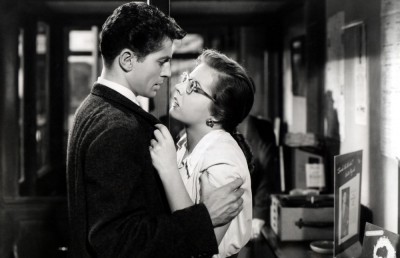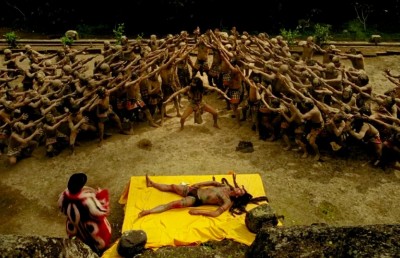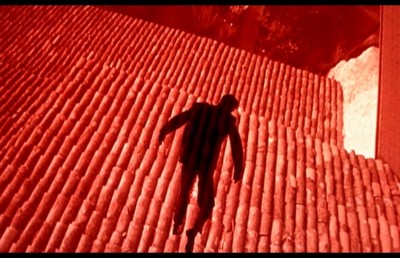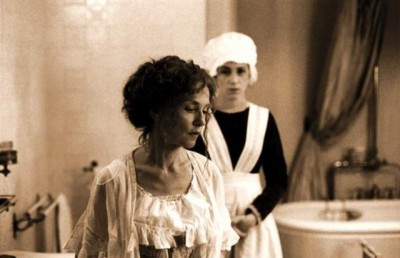Paraguayan Hammock
Waiting for Rain
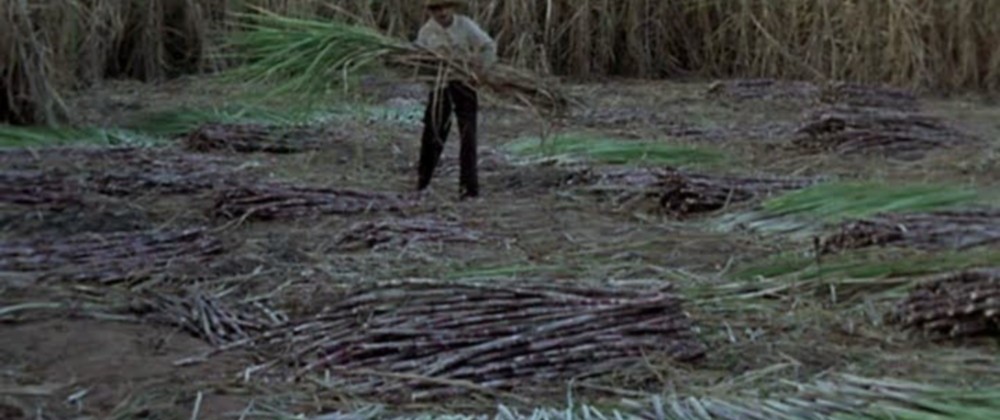
Paraguayan Hammock just may be the slowest paced film I’ve ever seen. At 76 minutes and 34 shots (I counted while watching, so may be off by one or two), the film settles in at a very slow average shot length (ASL) of about two minutes, but what makes the pacing feel slow is the near complete lack of movement. The camera is static throughout, usually from afar, extreme long shot range, framing the two old central characters, husband and wife Ramon (Ramon Del Rio) and Candida (Georgina Genes), as they lounge about on their hammocks. There is so little movement that on the few odd occasions where the camera cuts to a medium or close shot, one feels as of they’ve been transported into another film. The expression, “like watching paint dry” or “watching a car rust” is apt for this film, but without the usual negative associations. The film is a true account of a particular expression of time which the Japanese call sabi (time passed, time passing, time lost, or time standing still). It is an aesthetic term which struck Andrei Tarkovsky to heart, who described the term in this way:
In his account of Japan the Soviet journalist Ovchinnikov wrote: It is considered that time, per se, helps to make known the essence of things. The Japanese therefore see a particular charm in the evidence of old age. They are attracted to the darkened tone of an old tree, the ruggedness of a stone, or even the scruffy look of a picture whose edges have been handled by a great many people. To all these signs of age they give the name, saba, which literally means ‘rust’. Saba, then, is a natural rustiness, the charm of olden days, the stamp of time. [1]

In addition to Tarkovsky’s definition, according to Murasaki Shikibu, “Sabi was a very old word, found as far back as the Manyoshu where it has the meaning of ‘to be desolate.’ It later acquired the meaning of ‘to grow old’ and is related to the word ‘to grow rusty.’ [2]
The film is thematically justified as an attempt to capture the psychological sense of time dripping like molasses as the old couple wait interminably for the return of their son from war (the Chaco war with Bolivia). The importance of the hammock –an object associated with lounging and resting– is an apt signifier for the film’s lack of activity. I saw the film at the Cinémathèque Québécoise, where it was described in the catalogue as such (my translation from French): “June 14, 1935. It is autumn, but the heat persists. In an isolated area of Paraguay, Candida and Ramon, an elderly rural couple, wait for their son, who left for the front to fight in the Chaco War. [3] They are also waiting for the rain, the wind, for the eclipse of the heat, and for their son Masimo’s dog to stop barking. In the end, they await better times.” This plot description is threadbare, but it pretty much includes everything that happens in the film! Well no, there is the one scene where Ramon goes to the sugarcane plantation to cut down some sugarcane. This scene of an elderly man laboriously chopping sugarcane is the film’s defining moment of ‘action,’ along with Candida’s moment of action, when she goes to nearby stream to wash laundry. After the film my friend who had seen the film with me wondered what expression could describe the film beyond even ‘miserabilism’ and I added, ‘para-miserabilism’! So there you have it, the first ‘para-miserabilism’ film. The one film that came to mind during this film was Sokurov’s autumnal masterpiece Mother and Son, especially with the use of thunder, and the restriction of two characters in an isolated rural area, waiting for death. But once again, my friend chimed, “yes but this film makes Sokurov’s feel like an action film!”
With so little happening during the film’s central set-piece –the couple framed from afar sitting on their hammock in the forest clearing– our eyes begins to wander and we begin to observe subtle changes in light caused by the sun’s rays filtering through the heavy tree foliage. We listen more attentively to the myriad of overlapping natural sounds –barking dog, chirping birds, thunder, insects. Every small, subtle gesture of sound and image becomes dramatic. Our senses have become re-sensitized, and we become more attuned to the everyday.

Paraguayan Hammock, which is not only director Encina’s (a woman) debut feature, but is –according to Deborah Young of Variety, the “first 35mm all-Paraguay feature since the ‘70s.” [4] For anyone who was waiting all this time for a Paraguayan feature, it is only apt that Paraguayan Hammock feels like a Latin version of Waiting for Godot, because the couple spend most of their time lounging on their hammock, waiting and talking repetitively in circular lines about a limited range of subjects. For example, where the state of the barking dog we hear off screen is concerned, according to the two characters, the barking could mean that the dog may be upset, angry, hungry, and when not barking it could mean that the dog may be sick or dead. The other subjects for discussion are the heat, the lack of water and rain, the war, and their son. The back and forth nature of their concern for the dog is indicative of the film’s treatment of time, meandering, unfocused, contradictory. At some measure the film is an absurdist comedy because of the circular, near non-sensical dialogue (spoken in one of the two official languages of Paraguay, the indigenous Guaraní). We accept the ludicrousness of the dialogue largely because of their advanced age (maybe they are suffering from Alzheimer’s and can’t recall what they’ve just said?). If it were a young couple it would automatically veer into the area of the absurd.
Some plot development occurs when we realize from a man who comes calling (also seen but not heard) that their son died at the front, but Candida, the mother, refuses to accept the news, arguing that their son has a middle name, and that everyone that lives around them –although we only see other people in one brief shot– has a son with that name (another part of the absurdism). Instead they continue hoping and waiting. Not only do lines repeat but their sense of routine is so regimented that, at times, one gets the sense that things are repeating. And indeed we are formally, with the constancy of a handful of shots repeated: the extreme long shot of them on the hammock, the (point of view?) shots of the clouds, at times out of focus, nebulous, heavy, full of rain. Of the 34 shots in the film I’d say about half of them are comprised of shots of the hammock and the clouds. There is only one shot where more than these two characters are seen: a nice laterally composed shot after a group of women have washed their clothes in a stream, which is also the only occasion we see young characters in the film. Otherwise, there are ostensibly only a few locations in the film: the overhead sky/clouds (if this can be called a ‘location’), which normally follows the long shot of them on the hammock (framed with a huge tree on screen right and their farm behind), the sugarcane fields (in one brief scene), the front porch of their home, and the area in front of their outside clay oven where Candida receives news of her son’s supposed death.
As implied earlier, the unusual use of sound is one of the film’s most interesting formal aspects. The first shot –which we return to frequently– has the camera so far from the two characters that we can’t see their mouths, so we can’t tell for sure whether the sound is being recorded life or not, or whether their lips are moving. But in a few later shots where the camera is closer we see that there is no lip movement. Ramon and Candida have a series of dialogue exchanges with characters who are off-screen (either literally, or figuratively): their son Masimo (flashback voice-overs), the village authority who tells Ramon that the war has been over for a few days; and a military appointee who comes to tell them that their son has died at the front. We never see these people, and never see Ramon or Candida speaking to these characters. In the exchanges between Ramon and the village authority and Candida with the army official, the camera is close enough to see that neither character’s lips are moving when they are ‘speaking.’ Everything we hear is either occurring in a character’s mind (mind screen, to use Bruce Kawin’s term), is a flashback account, or a disconnect between time/space: the sound is occurring later/before the image, or is a strange form of indirect subjectivity. The effect is to increase the emotional distance between us and the film/characters. What is also unsettling, as noted by Young, is that we hear the sound as if in “close-up voice-over” while the characters are far from the camera. And, “Guido Berenblum and Victor Tendler’s meticulous sound recording deserves special mention, incorporating the sounds of nature into the couple’s personal drama.” [5]
The film ends as it begins. It opened with the elderly couple arriving from out of the forest clearing to pose their hammock on the trees and rest on it. It ends with them on the hammock, only now it is later, end of the day (June 14, 1935), light turning to dark, as they decide to head to bed before darkness engulfs them. They take down the hammock and walk back into the background of the forest clearing. The film is a continual discourse around death, mortality, waiting, old age, war, hope, and pessimism. I was struck by how well the film negotiated these two latter, contradictory poles: optimism and pessimism. On the one hand the film’s turgid pace automatically signals pessimism, as does the constant autumnal mood in the lighting, the constant sound of thunder, without rain (so much so that at one point I began to wonder whether the sound of thunder was subjective), and the rigorous evolution from daybreak to dusk. At a point near the end Ramon and Candida talk about a ‘pain in the chest’ which Ramon feels, a pain of loss and sorrow at the death of their son, which they seem to renege at one moment and accept at another. Ramon wonders that perhaps the gust of wind he felt was death coming to call. But Candida counters his seeming acceptance of death by saying that she will do her best to avoid the path of death. Hence they seem to waver from one moment to another, from acceptance of their old age and imminent death, and stubborn refusal to acquiesce to Father Time. They talk constantly of the unbearable heat, and the dryness caused by lack of rain. At one point saying that the dog may die because of lack of drinking water. Their land, their farm, is also suffering the drought. However, in the final shot they slowly (well, they do everything slowly) get up, Ramon picks up the lamp he only just lit, Candida removes the hammock, and they turn to head back to the comfy confines (I can only imagine) of their home before darkness engulfs them. The image fades to black, and, finally, after nearly an hour of unresponsive thunder, with the frame totally black, it begins to rain. Hope at last?
Endnotes
1 Andrei Tarkovsky, Sculpting in Time: Reflections on the Cinema, Kitty Hunter-Blair, trans. (Austin: University of Texas Press, 1996), 59. The word here has been translated to saba, but the more common English translation is sabi.
2 “On the Art of the Novel,” ed. WM. Theodore de Bary, in Japanese Aesthetics and Culture, 53, Nancy G. Hume, ed., Albany: State University of New York Press, 1995.
3 The Chaco War (1932–1935) was fought between Bolivia and Paraguay over control of a great part of the Gran Chaco region of South America, which was incorrectly thought to be rich in oil (wikipedia (Accessed March 28, 2008).
5 ibid.



